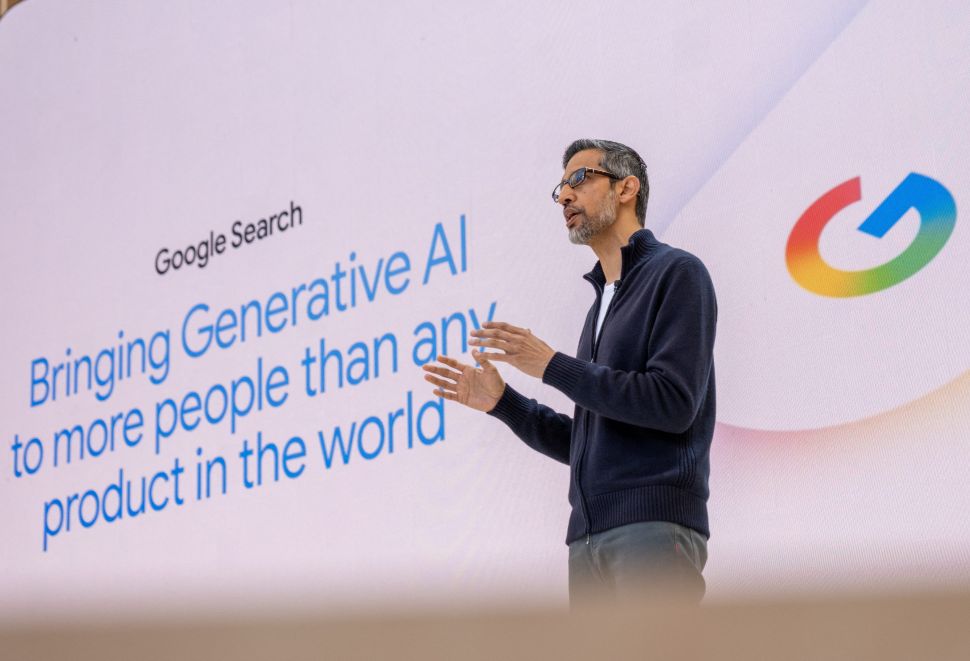Google CEO Sundar Pichai addresses the crowd during Google’s annual I/O developers conference” width=”970″ height=”661″ data-caption=’Google CEO Sundar Pichai addresses the crowd during Google’s annual I/O developers conference in Mountain View, California on May 20, 2025. <span class=”lazyload media-credit”>CAMILLE COHEN/AFP via Getty Images</span>’>
At Google’s I/O developers conference this week, CEO Sundar Pichai demonstrated Google’s latest progress in agentic A.I., systems that mirror key aspects of human behavior and are capable of carrying out multi-step tasks with minimal prompting. “We think of agents as systems that combine the intelligence of advanced A.I. models with access to tools. They can take actions on your behalf and under your control,” Pichai said onstage.
Agentic features are now rolling out across Google’s product lineup, from Chrome and Search to the Gemini app.
For example, Gemini Live, a new feature within the Gemini app, allows the A.I. assistant to “see” through a user’s phone camera and read on-screen content—building on last year’s Project Astra, a prototype that could respond to spoken questions with visual awareness. Pichai described Gemini Live as “the start of a universal A.I. assistant capable of perceiving the world around you.” During a demo, Gemini Live interpreted real-world objects, answered environment-based questions, and collaborated across apps to help users complete tasks.
Pichai also introduced Project Mariner, an advanced A.I. agent developed by Google DeepMind. Initially released as a research prototype in December, Mariner can now browse and interact with websites autonomously, conducting tasks such as filling out forms and completing transactions.
Project Mariner is behind “Agent Mode,” a new Gemini feature that allows users to delegate tasks like apartment hunting, booking appointments or trip planning. “We are introducing multitasking in Gemini, and it can now oversee up to 10 simultaneous tasks,” Pichai said. “It’s also using a feature called teach and repeat—where you show it a task once, and it learns how to handle similar ones in the future.” For instance, Gemini can find listings on sites like Zillow and apply very specific filters on the user’s behalf.
Agentic A.I. takes Google’s creative suite to another level
Some of the most striking announcements at this year’s I/O conference came from Google’s creative A.I. suite, where agentic intelligence is used to revolutionize content production.
Pichai debuted Veo 3, the latest generative video model capable of producing cinematic-quality clips with synchronized sound and intricate visuals. He also introduced Imagen 4, an upgraded image-generation model, and Flow, an agentic filmmaking assistant that can expand a single clip or prompt into a full scene. Unlike traditional tools that require step-by-step direction, Flow can transform a rough idea into a polished, Hollywood-style production with minimal input.
These advancements, Pichai noted, are powered by Google’s Gemini 2.5 Pro architecture and its next-generation TPU hardware, Ironwood. Built for speed and efficiency, Ironwood enables large-scale, real-time A.I. workloads at reduced cost—an essential requirement for agentic A.I., which must process audio, visual and contextual data continuously to act in real time.
Gemini 2.5 now supports not just the Gemini app and creative tools but also Google Search and its AI Overviews, offering more advanced reasoning and responsiveness. In A.I. mode, users can input queries two to three times longer and more complex than traditional searches.
Pichai also previewed new multi-turn interactions in Search, allowing users to ask follow-up questions in a conversational flow—a feature reminiscent of Perplexity AI.
“This is an exciting moment for A.I.,” Pichai said. “We’re just beginning to see what’s possible when A.I. understands more of the world around you—and can take meaningful action.”

